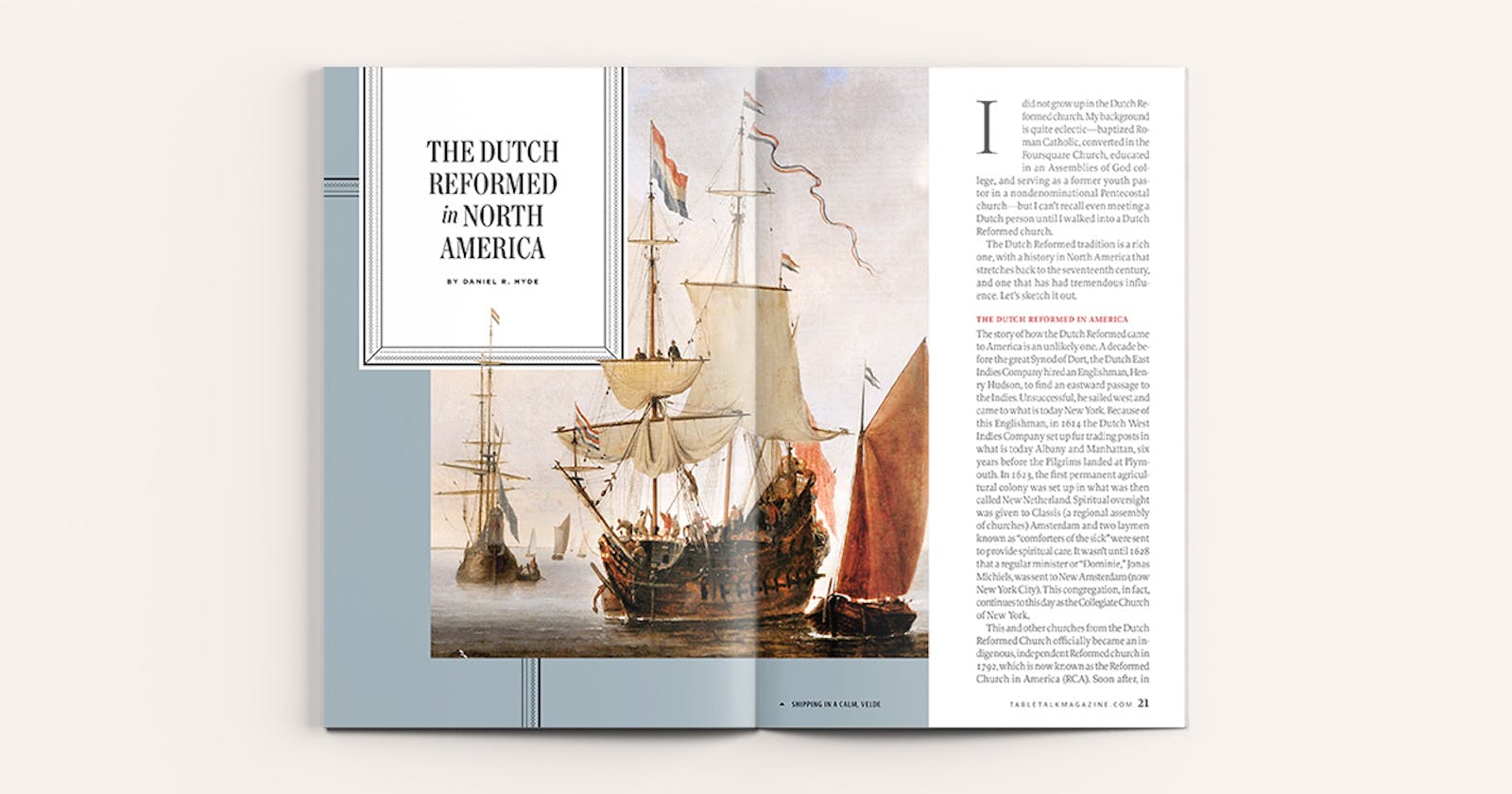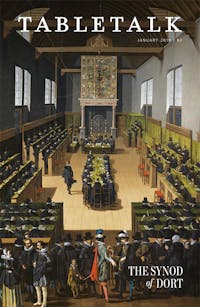
Request your free, three-month trial to Tabletalk magazine. You’ll receive the print issue monthly and gain immediate digital access to decades of archives. This trial is risk-free. No credit card required.
Try Tabletalk NowAlready receive Tabletalk magazine every month?
Verify your email address to gain unlimited access.
I did not grow up in the Dutch Reformed church. My background is quite eclectic—baptized Roman Catholic, converted in the Foursquare Church, educated in an Assemblies of God college, and serving as a former youth pastor in a nondenominational Pentecostal church—but I can’t recall even meeting a Dutch person until I walked into a Dutch Reformed church.
The Dutch Reformed tradition is a rich one, with a history in North America that stretches back to the seventeenth century, and one that has had tremendous influence. Let’s sketch it out.
The Dutch Reformed in America
The story of how the Dutch Reformed came to America is an unlikely one. A decade before the great Synod of Dort, the Dutch East Indies Company hired an Englishman, Henry Hudson, to find an eastward passage to the Indies. Unsuccessful, he sailed west and came to what is today New York. Because of this Englishman, in 1614 the Dutch West Indies Company set up fur trading posts in what is today Albany and Manhattan, six years before the Pilgrims landed at Plymouth. In 1623, the first permanent agricultural colony was set up in what was then called New Netherland. Spiritual oversight was given to Classis (a regional assembly of churches) Amsterdam and two laymen known as “comforters of the sick” were sent to provide spiritual care. It wasn’t until 1628 that a regular minister or “Dominie,” Jonas Michiels, was sent to New Amsterdam (now New York City). This congregation, in fact, continues to this day as the Collegiate Church of New York.
This and other churches from the Dutch Reformed Church officially became an indigenous, independent Reformed church in 1792, which is now known as the Reformed Church in America (RCA). Soon after, in 1822, there was a small secession of churches from Classis Hackensack (a classis of the Northeastern United States). A key issue was the teaching of what was called “the New Divinity,” or Hopkinsianism (named after Samuel Hopkins). This theology taught a form of original sin, free will, and Christ’s satisfaction that was different from what was taught in the Canons of Dort. Those who seceded called themselves the True Dutch Reformed Church (TDRC).
Problems Back Home
Back in the Netherlands, not only had rationalism and Pietism infected the Dutch Reformed Church, but the Napoleonic era also especially wrecked havoc. After Napoleon’s defeat, the Congress of Vienna installed the exiled William, Prince of Orange and Nassau, as King William I over the new constitutional monarchy of the united Dutch provinces. In 1816, he passed a law called the General Regulations that reorganized the churches into a state church, calling it the Netherlands Reformed (or Reorganized) Church. The church order adopted back at the Synod of Dort stressing the authority of local consistories (ruling bodies of ministers and elders) was replaced with a government-created hierarchical structure of boards. Dort’s form of subscription, which required church officers to subscribe to the doctrine of the Three Forms of Unity—the Heidelberg Catechism, Belgic Confession, and Canons of Dort—was changed. Previously, the subscription had indicated agreement because the Three Forms agreed with the Word of God; this was changed so that reference to the canons was removed and subscription to the catechism and confession was only insofar as they agreed with the Word. One minister, Simon van Velzen, defended the Three Forms of Unity before his classis’ board, leading one of its members to say, “I’d rather have my neck wrung than subscribe to the Canons of Dort.”
This unrest led conscientious believers to meet in extra-ecclesiastical “conventicles” to read the classic Reformed works as part of a movement sweeping across Protestant churches throughout Europe called the Revival. The result of this revival was the Separation in 1834. Dominie Hendrick De Cock in Ulrum was so impressed by the zeal and piety of those in his flock who met in conventicles that he began to read Dort’s authorized State Bible, John Calvin’s Institutes, and the Canons of Dort. The result was a convicted man whose preaching began to draw great crowds. In response, the government suspended him from preaching and later deposed him from the ministry after he wrote an introduction to a pamphlet against the state’s obligatory law that the church sing hymns. In De Cock’s place, H.P. Scholte preached and also objected to the state’s requirement to sing hymns, so he too was suspended within two weeks. This led the consistory of Ulrum to action on October 13, 1834, in a signed statement titled Act of Secession and Return. The next evening, most of the congregation signed the document. Other congregations whose ministers had been deposed for not singing the obligatory hymns and refusing to baptize children of noncommunicant members joined in the Separation. The government-run state church persecuted Separation people by putting soldiers in their homes, fining those at conventicle meetings of more than twenty, and imprisoning those who did not pay.
Spread through Immigration
By 1847, Separation ministers and members had begun to immigrate to the United States and set up independent colonies and churches in Holland, Mich., and Pella, Iowa. These immigrants initially came into contact with and united with the RCA. Soon after, a man in the Holland church named Gijsbert Haan began to call for secession from the RCA after receiving information from the True Dutch Reformed Church and after worshiping in several RCA congregations. His reasons for secession included the following:
- Preaching from the Heidelberg Catechism, which was a hallmark of Dutch Reformed churches since before the Synod of Dort, was nonexistent.
- The five “evangelical feast days” were not celebrated (Christmas, Good Friday, Easter, Ascension, and Pentecost).
- Baptism was administered privately in homes and the consistory room.
- African Americans were segregated at the Lord’s Table.
- Membership in Masonic lodges was accepted.
- Some ministers and elders joined in a Methodist communion service.
- Hymns and choirs began to have prominence.
- Sunday school supplanted catechism instruction.
In 1857, the four immigrant congregations in Holland left the RCA and became the True Holland Reformed Church. By the mid-1860s, these churches began corresponding with the True Dutch Reformed Church and a merger occurred in 1890, creating the Christian Reformed Church (CRC).

All’s Not Well on the Western Front
Unfortunately, the Dutch Reformed in North America have been plagued by theological controversy. After the start of the twentieth-century, struggles entered the CRC. One flashpoint was Harry Bultema and his book Maranatha, wherein he defended premillennial dispensationalism and its denial of the kingship of Christ over the church and the unity of the Old and New Testaments. Bultema’s views were discussed and condemned by his classis and by the synods of 1918 and 1920 as being contrary to the Reformed confessions. Another struggle was over Ralph Janssen, professor of Old Testament at Calvin Theological Seminary in Grand Rapids. Janssen questioned the infallibility and authority of Scripture and cast doubt on some biblical miracles, explaining them from natural causes. The synod of 1922 condemned his views and relieved him of his position at the seminary.
Sadly, this general tendency within American Christianity to lessen the authority of Scripture led to decline in the CRC over the ensuing decades. Especially in the 1960s, there was a growth of doctrinal indifference resulting from a more liberal interpretation of the Scriptures. The changes were becoming noticeable in the preaching as well as in the liturgies of some churches. Catechism books and Sunday school materials used in the churches began to stress human experience. Doctrinal sermons became more infrequent in many churches, with a published survey showing the Heidelberg Catechism no longer being used in preaching in a majority of congregations. This growing doctrinal indifference became ignorance with a benign disregard or a limited acceptance of issues such as evolution and women elders.
Another Wave of Secession
By the 1980s, conservative members in the CRC were creating organizations, producing reading materials, and challenging and condemning the direction and decisions of various synods. One small secession took place among Canadian churches and was called the Orthodox Christian Reformed Churches. Other groups were formed, including the Consistorial Conferences and the Christian Reformed Alliance, which in the 1990s became the Alliance of Reformed Churches. This trend continued until 1995, when the United Reformed Churches in North America (URCNA) was constituted, holding its first synod in 1996.
The Dutch Reformed movement, like all others, is engaged in a constant struggle. There is growth, there is decline; there is reformation, there is deformation leading to revival and renewal of the old paths. In this anniversary year of the Synod of Dort, I write as one who is thankful for this long struggle and who found himself transplanted as an outsider into the world of Dutch Reformed churches. I’m thankful for the struggles of men within this branch of Christ’s church such as Geerhardus Vos and his emphasis on the unfolding revelation of God’s Word, and Louis Berkhof and his faithful appropriation of the orthodox and pious theology of Herman Bavinck. I’m indebted to more recent men who led to the formation of the URCNA: W. Robert Godfrey, one of the leading lights of the Dutch Reformed world who, like me, came in from the outside; Cornelis Venema and Kim Riddlebarger and their writing on justification and eschatology; and Michael Horton, who has led so many like me into a modern Reformation.
